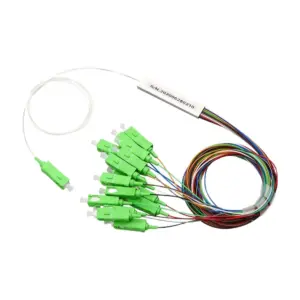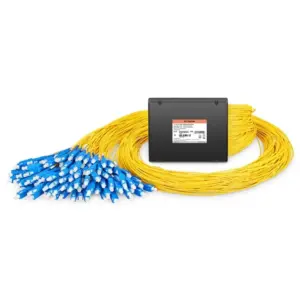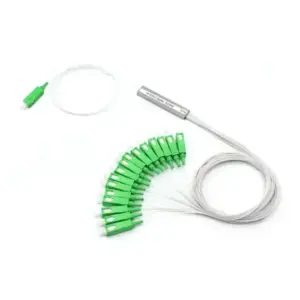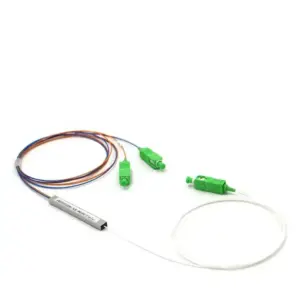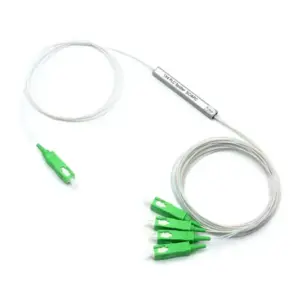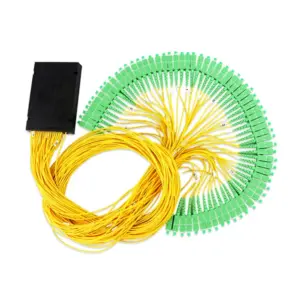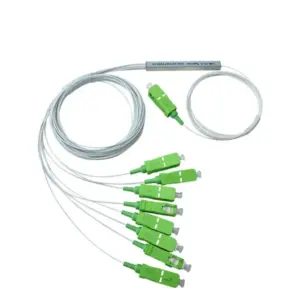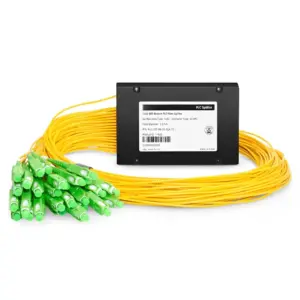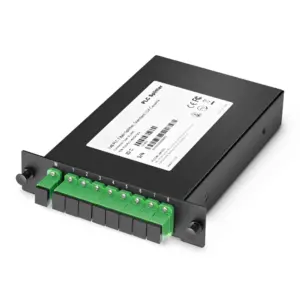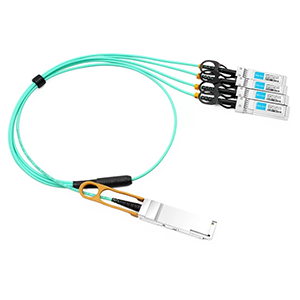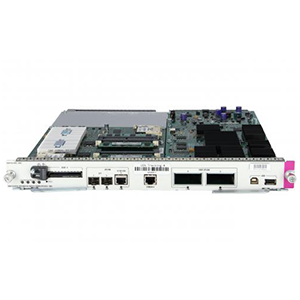This article will comprehensively discuss the structure, working principle and application of fiber optic plc splitter in communications, data centers and industrial automation. It will also analyze its advantages and challenges and look forward to the technological trends of future development. . I hope that through this article, you will have a deeper understanding of fiber optic PLC splitters and realize its current and future importance, providing more reference and inspiration for your business and project choices.
1. Introduction to fiber optic PLC splitter
A. Basic concepts of fiber optic PLC splitter
The optical fiber PLC optical splitter is an important device used in optical fiber communication systems. It is used to distribute optical signals to multiple output ports or combine multiple input signals into one output port. The basic concept is to use optical waveguides on optical waveguide planar chips to achieve distribution and merging of optical signals by etching different waveguide structures on the chip surface.
The principle of PLC optical splitter is based on optical phenomena such as total internal reflection of light and multi-mode interference. When the optical signal enters the PLC chip from the entrance, it will be distributed or combined among different waveguides according to the design and structure on the chip, and finally achieve the expected optical power distribution ratio.
B. Structure and principle of fiber optic PLC splitter
Structure:
- Fiber PLC optical splitter usually consists of three main parts: input port, optical waveguide planar chip and output port.
- The input port is the entrance to introduce optical signals into the PLC chip.
- The optical waveguide planar chip is the core component of the PLC optical splitter, which contains structures such as optical waveguides and couplers, and is used to distribute or combine optical signals.
- The output port is the port that outputs optical signals from the PLC chip. There can be one or more.
How it works:
- The optical signal enters the PLC chip through the input port.
- On the chip, optical signals are distributed or combined through different optical waveguide structures depending on the chip’s design.
- The distribution and merging process is achieved through optical phenomena such as total internal reflection of light and interference.
- Finally, the optical signals are distributed or combined into the expected output ports to complete the splitting or combining function of the optical signals. The advantages of PLC optical splitters include compact structure, low loss, high reliability, and wide application in multi-wavelength and high-speed communication systems.
2. Application fields of fiber optic plc splitter
A. Applications in the field of communications: optical fiber networks and optical fiber communication systems
Fiber optic PLC splitters play a key role in the communications field. They are widely used in optical fiber networks and communication systems for the distribution, multiplexing and integration of optical signals. In optical fiber communication systems, PLC optical splitters can realize the distribution of optical signals, so that an optical signal can be received by multiple receiving ends at the same time, thereby improving the efficiency and flexibility of the optical fiber network.
B. Data center applications: data transmission and distribution
In data center environments, fiber optic PLC splitters are used for data transmission and distribution. They can transmit high-speed optical signals from the backbone network of the data center to different servers or terminal devices to achieve efficient distribution and management of data. Because PLC optical splitters have the characteristics of low loss and high reliability, they have been widely used in high-density data transmission environments in data centers.
C. Applications in Industrial Automation and Sensor Networks
In industrial automation and sensor networks, fiber optic PLC splitters also have important applications. They can be used to connect different sensor nodes and control units to realize the collection, transmission and processing of industrial data. Because fiber optic PLC splitters have the advantages of strong anti-interference ability and long transmission distance, they can work stably and reliably in industrial environments and are suitable for various industrial automation and sensor network application scenarios.
3. Advantages and challenges of fiber optic plc splitter
A. Advantages:
- High performance: Fiber PLC optical splitters have excellent optical performance and can achieve precise optical signal distribution and merging, ensuring the stability and reliability of the communication system.
- Low loss: PLC optical splitter has less loss during optical signal transmission and can effectively maintain the strength and quality of the signal.
- Reliability: Due to the adoption of mature optical technology and manufacturing processes, fiber optic PLC splitters have high reliability and can work stably for a long time, reducing system maintenance and failure rates.
B. Challenge:
- Manufacturing complexity: The manufacturing process of fiber optic PLC splitters is relatively complex and requires precise processing and process control, which increases manufacturing costs and production cycles.
- Cost: Due to high manufacturing complexity, the cost of fiber optic PLC splitters is relatively high, which may limit its popularity and adoption in certain applications.
- Difficulty of integration and testing: For multi-channel optical splitters or high-channel-number optical splitters, the integration and testing process may be more complex, requiring strict quality control and testing processes, increasing the difficulty of manufacturing and verification.
Overcoming these challenges requires continuous technological innovation and process improvement to improve manufacturing efficiency, reduce costs, and further improve the performance and reliability of fiber optic PLC splitters.
4. Technology trends and future development directions
A. Continuous pursuit of high performance and low loss:
- In the future, fiber optic PLC splitters will continue to pursue higher performance and lower signal loss to meet the growing demand for optical communications.
- The research and development of new materials and the application of advanced manufacturing technology will promote the performance improvement of optical splitters, achieving lower insertion loss and higher signal transmission efficiency.
B. Expansion of multi-wavelength and multi-mode support:
- In the future, fiber PLC optical splitters will pay more attention to supporting multi-wavelength and multi-mode optical signal transmission to cope with complex communication systems and diverse optical network requirements.
- For optical signals of different wavelengths and modes, optical splitters need to provide flexible distribution and combining functions to achieve more efficient optical signal processing.
C. Manufacturing process improvement and cost reduction:
- In the future, the manufacturing process of optical fiber PLC splitters will be further improved and more intelligent and automated production technologies will be adopted to reduce manufacturing costs and improve production efficiency.
- Quality control and testing technology during the manufacturing process will also be strengthened to ensure product quality and reliability.
D. Application of fiber optic PLC splitters in emerging fields such as 5G and Internet of Things:
- With the rapid development of 5G communication technology and the Internet of Things, fiber optic PLC splitters will be used in more emerging fields to support high-speed, large-capacity, and low-latency data transmission requirements.
- In the fields of smart cities, industrial automation, smart transportation and other fields, fiber optic PLC splitters will play an important role in providing reliable infrastructure support for data transmission and communication networks.
Summary:
As an important part of the optical communication system, the optical fiber PLC optical splitter plays a key role in the distribution and merging of optical signals. Its emergence has greatly promoted the development and application of optical communication technology. By distributing optical signals to different channels or combining multiple signals into one, PLC optical splitters enable the flexibility, efficiency and reliability of optical networks. In fields such as optical fiber networks, data centers, and industrial automation, optical fiber PLC splitters have broad application prospects and can support the growing demand for data transmission and the development of communication networks.
As a key component of optical communication technology, fiber optic PLC splitters will continue to play an important role in the future. We look forward to the emergence of higher performance, lower loss fiber PLC splitters to meet the growing communication and data needs.
We encourage innovation and technological breakthroughs to inject more vitality into the development of optical fiber PLC splitters and help the optical communications field move towards a more brilliant future. Choose fiber optic plc splitter, choose excellent performance and reliable quality, and let us work together to create a new era of optical communications!
-
128-channel optical fiber PLC splitter
-
16-channel optical fiber PLC splitter
-
2-way optical fiber PLC splitter
-
32-channel optical fiber PLC splitter
-
4-way optical fiber PLC splitter
-
64-channel optical fiber PLC splitter
-
8-channel optical fiber PLC splitter
-
ABS module PLC fiber optic splitter
-
Box PLC optical fiber splitter

